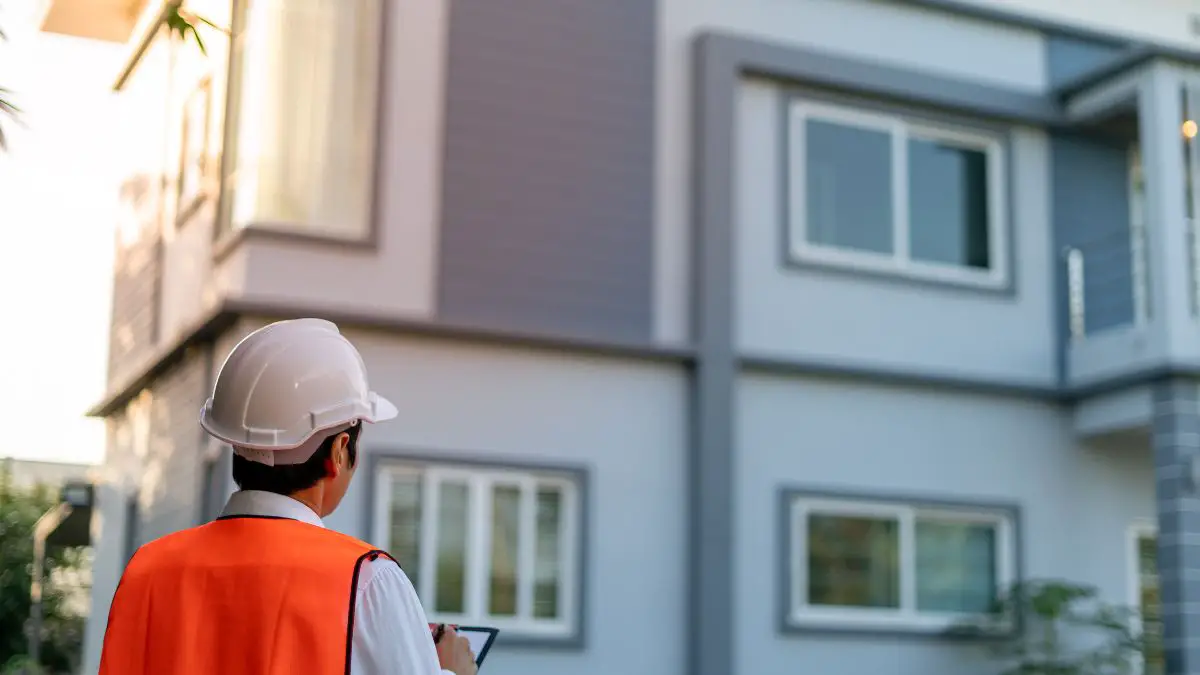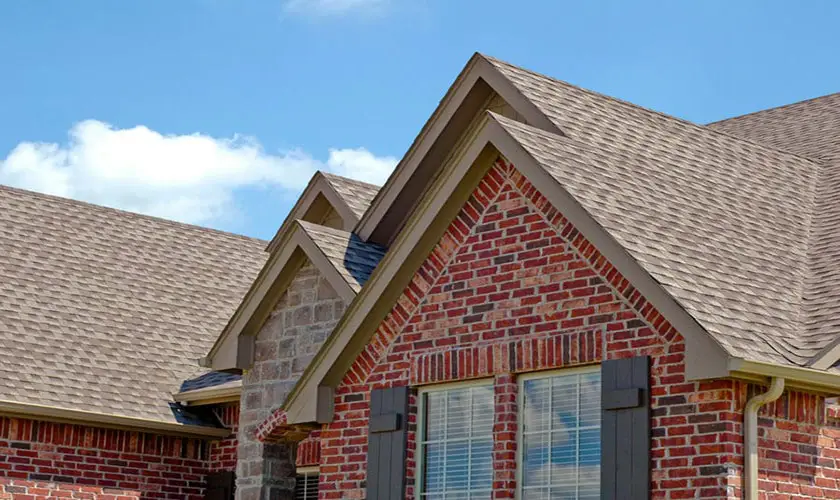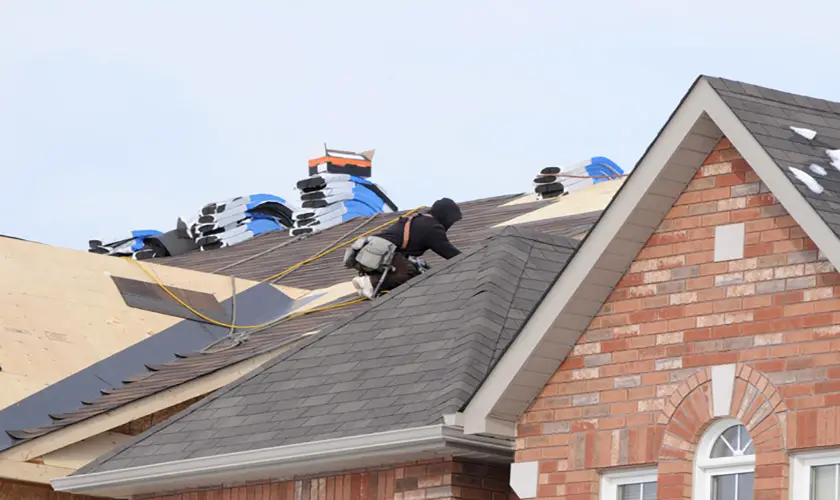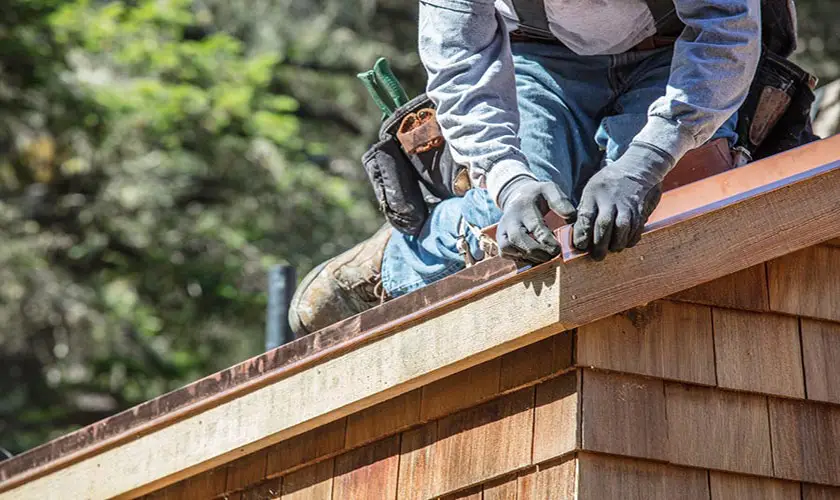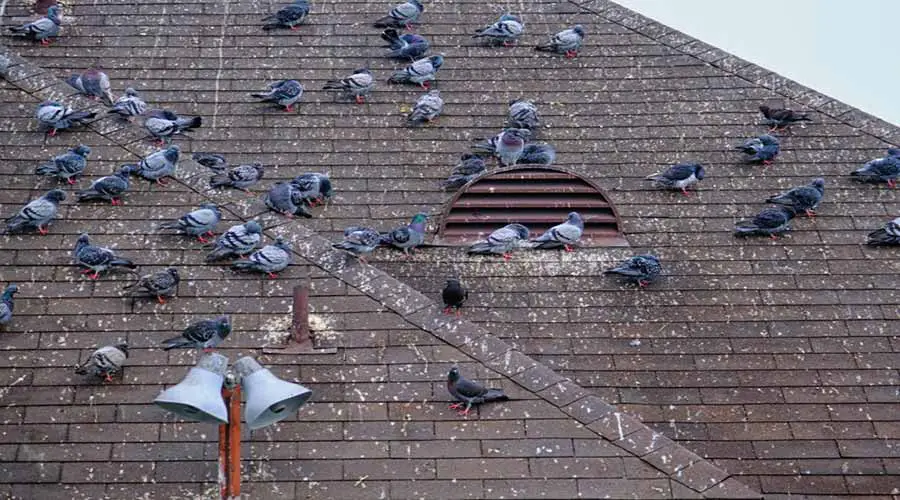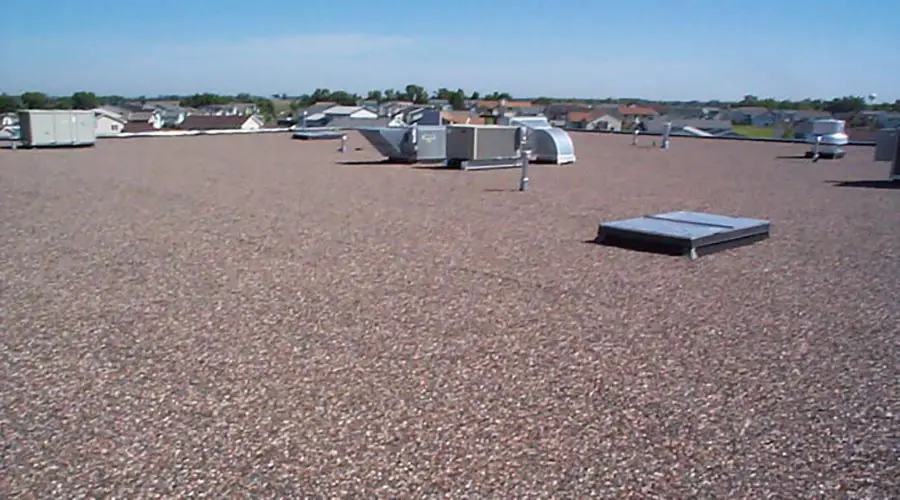
Built-up roofing, also called BUR, is among the most commonly used roofing systems for flat-roofed buildings. BUR systems are somewhat complicated and require teams of roofers to install correctly. BUR is a unique roofing system for flat or low-pitch roofs. Let’s discuss built-up roofing further.
Built-up roofing (BUR) is a system of layered fabric roofing panels applied and sealed with an industrial adhesive such as asphalt that is placed on top of the flat roofing structure of a building and covered in aggregate material. It is inexpensive and effective. BUR lasts for up to 40 years.
BUR is one of the best options for many buildings, but there is much to understand before using it on a building. BUR is a unique roofing system that you must know before being applied to any building. Let’s take a closer look at built-up roofing. Here’s a complete guide to BUR.
What Does A Built-Up Roof Mean?
“Built-up roof” is a term in the construction industry. If you are unfamiliar with this term or this roofing style, you may be wondering, “what does a built-up roof mean?”
A built-up roof is a roof that has been treated with the application of specialized roofing materials to strengthen, seal, and finish low-slop roofs. A BUR consists of multiple layers of adhesive materials, alternating ply sheet fabrics, and surfacing materials and finishes.
This method of finishing a roof has been around for a long time, and it is one of the most common and popular methods for completing a flat roof or a roof with minimal slope.
A built-up roof is a roof with multiple layers of specialized materials and adhesives.
A roof that is left unfinished is susceptible to damage and is likely to develop leaks and cracks. Still, a roof built up has been properly sealed and finished, strengthening the roof and preventing damage such as leaks and cracks while significantly lengthening the roof’s lifespan.
A built-up roof usually comprises three essential components: layers of reinforcing fabric known as ply sheets, adhesives such as bitumen or asphalt to seal the ply layers onto the roof, and a top layer of material to finish it all off.
Modern built-up roofs incorporate insulation layers to improve further the structure and quality of the buildings’ roofs.
The layers of roofing material are layered or built up one sheet straightforward and stuck together with a hot or cold adhesive such as bitumen.
During the install, you add layers of insulation then the entire roof is sealed with a reflective spray-on coating to defend against the elements. When these layers are complete, you apply a surface of aggregate material over the top of the roof. This layer helps to further protect the roof from impact damage and harsh UV rays.
The exact materials used for BUR may vary, depending on the contractor installing the roofing, the available budget for completing the roof, the weather exposure, and the available time for the project to be completed.
You install BUR materials on flat or low-slop roofs. You can not install it on sloped roofs due to the method of its application.
Some of the common materials used for BUR include:
- Asphalt
- Bitumen
- Cold adhesive
- Fiberglass
- Pearlite
- Organic fabric compounds
- Gravel
- Stone
How Long Does A BUR Roof Last?
BUR has been commonly used worldwide for many years, but how long does this type of roof last?
BUR lasts between 15 – 40 years, depending on the materials used in the roofing.
Other factors that affect the lifespan of BUR are the climate exposure of the roof and how well the BUR is installed and applied. Cold temperatures reduce the lifespan of BUR. The number of layers in the BUR will also determine its longevity.
Built-up roofing is long-lasting roofing in terms of flat roofs. BUR should last 25 to 40 years before requiring replacement. However, the roof will require maintenance.
BUR lifespan depends on design and installation. Each layer of built-up roofing also called plies, equates to around five years of the roof’s life. The more layers used, the longer the roof will last.
The materials play a pivotal role in how long the roof will last as well. BUR that uses cold adhesive will last longer than BUR applications with hot adhesive. The type of fiber used for the ply layers is also a factor.
The nature of BUR means that it does not last as long in hot climates as it does in cold climates. Hot temperatures tend to cause the materials in BUR to delaminate more quickly, which causes the roof to become unstable relatively quickly.
The method of application of BUR is another factor that contributes to its lifespan. A well-applied BUR is likely to last far longer than a poorly applied BUR.
Overall, the average number of years that BUR will last is between 15 – 30 years.
Can A Built-Up Roof Be Repaired?
The methods used to install BUR may make one wonder if you can repair this type of roofing if it becomes damaged or weather-worn? Or must this roofing be entirely replaced if it becomes damaged or worn?
It is possible to repair the built-up roof if the damage is not too extensive. Built-up roofing does not last forever, but it will require some maintenance and the occasional repair along the way. Some BUR damage is too much to be repaired, which requires replacement.
The type and degree of damage the roof has sustained will determine the steps you should take to repair it. An average person can fix some built-up roof damage, but most of the damage found if this type of roof requires the attention of a professional roofer.
Built-up roofs are susceptible to damage caused by heat, sunlight, rough weather, impacts, and damage due to incorrect or inadequate installation.
The most common problems experienced with BUR are open joints, blisters, waves, and cracks.
Repairing Open Built-Up Roofing Joints
Open BUR joints occur when the joints within the roofing system become separated over time or due to events such as earthquakes. You should consult a professional roofer about repairing this type of damage to BUR.
Repairing open joints is done by pouring cement under the open joint and weighing it down to ensure adhesion. Using a section of professional roofing felt held securely with nails and roofing cement is another option for repairing an open BUR joint.
Repairing Built-Up Roofing Blisters
Heat or moisture under the top layer of roofing or roofing seal typically causes BUR blisters. Expanding vapors or air within the roofing material force the sealant layer to expand, causing a bubble within the roofing.
To repair BUR blisters, use a utility knife to relieve the pressure within the blister and cut the flap of sealant from the roof.
Once you remove the flap, spread roofing cement into the gap created by the blister and around the opening on the roof’s surface; next, use a strip of asphalt shingle, or roofing felt to seal the gap by pressing it into the roofing cement.
Cover the area with another layer of roofing cement, and roofing felt, and weigh it down while it dries to ensure it adheres well to the roof.
Repairing Built-Up Roofing Waves
BUR waves or undulations usually occur due to poor installation. These appear as small or large grooves on the roof’s surface where the seal has not correctly adhered to the underlying layers of the BUR.
To repair these waves, level the areas with another layer of BUR sealant and substrate. There is no reason to remove the damaged area, as it has already hardened. Instead, cover the area and smooth it over with a new layer to prevent any further damage.
Install the new layer correctly and seal it properly to avoid future repairs.
Repairing Built-Up Roofing Cracks
Cracks occur in built-up roofing over time. Imperfections cause these cracks in the roofing materials and from normal weathering.
Repairing cracks in built-up roofing is done by cleaning the area and re-applying a layer of cement and sealant used on the roof; this is usually roofing cement and a layer of bitumen or asphalt.
Applying a layer of this material will fill in the crack, but this is a short-term solution. A cracking roof will need to be seen to be a professional roofer and potentially replaced soon.
Basic BUR Repair Summary Table
| Type Of Damage | Requires Professional Attention? | Repairability | Repair Method |
|---|---|---|---|
| Open joints | Yes | Difficult to repair | Pour roofing cement into the opening, or cover and seal with roofing felt and cement. |
| Blisters / Bubbles | No | Simple to repair | Remove the blister and patch with roofing cement, and roofing felt. |
| Waves | No | Simple to repair | Cover and smooth the waves with BUR sealant and a layer of BUR substrate. |
| Cracks | Yes | Small cracks = simpleLarge cracks = difficult | Clean the area and fill cracks with asphalt or bitumen. |
Which Roofing Material Is The Most Durable?
Roofing materials do not last forever, but some last much longer than others. Which roofing material is the most durable, and how durable is BUR compared to other roofing materials?
Built-up roofing is not the most durable roofing material. The most durable roofing materials include natural slate tiles, clay tiles, concrete tiles, and metal roofing materials such as seam-metal roofing. BUR roofing falls about in the middle of the durability spectrum.
Built-up roofing utilizes multiple layers of flexible materials that are essentially glued together, nailed down, covered with adhesives and sealants, and then covered with a layer of gravel.
These softer construction materials are less durable than more rigid materials such as slate shingles or clay tiles. The more rigid roofing materials last for a much longer time than BUR, and roofing made from shingles can be repaired one shingle or tile at a time, rather than repairing entire sections of the roof or replacing it entirely.
BUR has an average lifespan of around 15 – 30 years. However, it is known to last for up to 40 years without requiring a replacement.
Asphalt rolls produce the least durable roofing materials as they may last as few as five years. The longest-lasting roofing materials, such as natural slate tiles, may last for as long as 150 years without requiring replacements. The lifespan of BUR means that it is about in the middle of the durability spectrum.
The most durable roofing materials are metal roofing materials such as corrugated metal roofing and seam-metal roofing. These rods can withstand more impact and direct harm than most other roofing materials.
This article is an excellent resource for more comprehensive details on the most durable roofing materials, including how much they cost and the pros and cons of each roofing material.
What Is The Best Material For A Flat Roof?
Deciding on which material to use for a flat or a low-pitch roofs is a challenge. These roofs tend to collect water, they are constantly beat on by harsh sun rays, and they are susceptible to damage from weather events such as hail. Which is the best material to use for a flat roof?
The best materials to use for a flat or low-pitch roof include PVC, polymer-modified bitumens, neoprene for single-ply membrane roofing. Built-up roofing is an excellent option as well, especially when considering the price of the roofing.
Single-ply or single-layer roofing materials are becoming more advanced. Various synthetic materials are very durable, simple, and cost-effective roofing solutions.
Flat or low-pitch roofs are a challenge to complete because of susceptible to the damage they are and how much maintenance they require. These roofs require materials and techniques that will last as long as possible.
The best material on the market for flat roofs is PVC.
PVC is a roofing material that requires very little maintenance as it is resistant to cracking and impact damage. PVC roofing is straightforward to install. It has a very long lifespan compared to other single-layer roofing materials. It is reflective, which helps to keep the temperature in the building down.
Many roofers prefer PVC roofing materials for these qualities, but it is more expensive than other materials.
When considering the price, one of the best roofing materials for a flat roof is BUR. this roofing material and the techniques used to install it are more than a hundred years old, demonstrating how effective this roofing is.
BUR is not the most durable or the most reliable flat roof material, nor is it the easiest to install, but it is the best material for the money for a flat or low-pitch roof.
How Much Does It Cost To Replace A Built-Up Roof?
Built-up roofing systems are some of the most cost-effective flat roofing systems available. We have established that these roofing systems are excellent for their price, but how much does it cost to replace a built-up roof?
A built-up roof can cost between $4.00 and $5.55 per square foot, depending on the quality of the roofing materials, the quality of the workmanship, and the roofing company charges’ price. This price per square foot means that a 10,000 square foot roof will cost $40,000 to $55,500.
These numbers may seem very large, but these figures are for an average flat roof, usually found in commercial rather than residential buildings. Smaller buildings with smaller roofs will be less expensive, but the average figures are around $4.00 to $5.55 per square foot of roofing.
Price changes occur because of the varying quality and materials available for BUR. Less expensive materials will reduce the overall roofing expenses while using more costly and better quality materials will increase the overall price.
This price includes the cost of materials and installation, but the contractor you use may charge more to remove the existing roofing before replacing the roofing system. The cost of removing the existing BUR is where the difference in price lies.
Try to find a roofer that will charge less to remove the existing roof before installing the new BUR. Achieving this will significantly reduce the price of the roofing.
Conclusion
Built-up roofing is one of the most cost-effective roofing solutions for building with flat or low-slope roofs.
BUR consists of layers of roofing materials placed on top of one another to build up the roof. Once the layers are in place, an adhesive seals the roof and is then covered with an aggregate material such as gravel or slate slabs to protect the roofing from harsh sun rays and impact damage.
Repairing built-up roofing can be simple, depending on the damage. Repairing blisters and small cracks are relatively easy, but joint openings and large cracks require the attention of a professional.
The average cost of installing a built-up roofing system is between $4.00 – $5.55, but the overall price depends on the size of the roofing project.
Built-up roofing systems are good value for money, but installing them is a challenge, and these systems do not last as long as some other roofing systems.
In the end, these roofing systems are ideal for flat roofs, and they are inexpensive enough to be replaced every 30 years when necessary, making built-up roofs one of the best options for almost every flat-roofed building.
References
Built-Up Roofing Types, Advantages, and Applications



